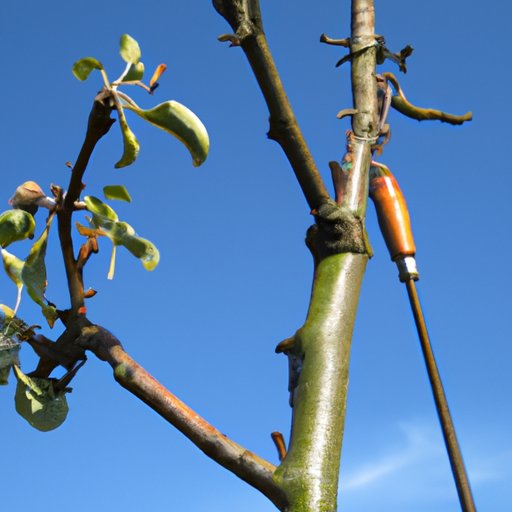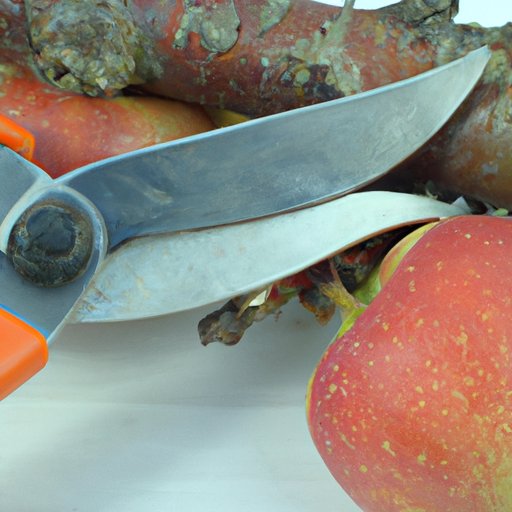
I. Introduction
If you’re looking for a way to improve the health of your apple trees and increase fruit production, pruning is the key. Pruning is an essential part of apple tree care and doing it correctly can help promote healthy growth, remove dead or diseased wood, and increase the overall yield of your tree. In this article, we’ll provide a comprehensive guide to pruning apple trees so that you can grow healthy trees and bountiful fruit.
II. Step-by-Step Guide to Pruning Apple Trees
Pruning should be done during the tree’s dormant season, typically in late winter or early spring before buds begin to swell. Here’s a step-by-step guide to pruning apple trees:
Best time to prune apple trees
Pruning is best done during the tree’s dormant season, typically in late winter or early spring before buds begin to swell. This is when the tree is less likely to suffer from disease or insect infestations, and when you can clearly see the tree’s structure without any foliage blocking your view.
Essential tools for pruning apple trees
Having the right tools for pruning is essential to ensure that your tree is pruned correctly. Here are the essential tools you’ll need:
- Hand pruners: for branches up to 1/2 inch in diameter.
- Lopping shears: for branches between 1/2 inch and 2 inches in diameter.
- Pruning saw: for branches larger than 2 inches in diameter.
- Pole pruner: for reaching high branches without a ladder.
- Gloves and safety goggles: to protect your hands and eyes while pruning.
Techniques for pruning the canopy and branches
When pruning apple trees, it’s essential to focus on removing dead, diseased or damaged wood, and any branches that are crossing or rubbing. Here are some key techniques for pruning the canopy and branches:
- Remove any water sprouts, suckers, and shoots that grow from the trunk or roots and any branches that are dead, diseased, or damaged.
- Prune out any crossing or rubbing branches, leaving the strongest and best-placed branches to form the tree’s structure.
- Thin out the canopy by removing some of the interior branches to promote air circulation and sunlight penetration.
- Prune back lateral branches to about 1/3 of their length to encourage new growth and enhance fruiting potential.

III. Benefits of Pruning Apple Trees
Pruning apple trees not only helps promote healthy growth but also has a range of other benefits:
Improved air circulation
Pruning your tree can help increase air circulation and sunlight exposure, which is essential for healthy growth. Better air circulation reduces the risk of fungal disease and insect infestations and enhances fruit ripening and color.
Increased growth and fruit production
Pruning can help stimulate new growth and encourage the development of fruiting spurs, which are the buds that will produce fruit in the following season. By removing excess branches and foliage, you can increase the tree’s energy to produce high-quality fruit.
Better pest and disease control
Pruning can help remove any diseased or infected wood from the tree, reducing the spread of disease and pests throughout the tree and to other plants in the area. It also helps open up the tree, making it easier to spot and treat any issues.
IV. Avoiding Common Mistakes When Pruning Apple Trees
While pruning apple trees is essential, it’s easy to make mistakes that can adversely affect the tree’s health, growth, and fruit production. Here are some common pruning mistakes to avoid:
- Pruning too much or too little. Over-pruning can reduce the tree’s fruiting potential, whereas under-pruning can hinder its growth and lead to a disorderly appearance.
- Pruning at the wrong time. Pruning at the wrong time of year can lead to disease and pest problems. Be sure to prune during the dormant season before the buds start to swell.
- Cutting too close to the trunk. This can cause damage to the tree’s bark and lead to disease. Leave a small collar of wood around the branch when cutting.
- Not using proper pruning techniques. Incorrect pruning can lead to wounds that take a long time to heal and leave the tree vulnerable to pests and diseases.
V. Pruning Techniques for Different Types of Apple Trees
Pruning techniques vary depending on the type and age of apple trees. Here are some techniques for pruning different types of apple trees:
Summer and winter pruning techniques
Summer pruning involves removing excess shoots and branches to maintain the tree’s shape and promote airflow. Winter pruning, on the other hand, involves removing dead, diseased, and damaged wood, as well as shaping the tree to promote fruit production.
Pruning young trees versus mature trees
Young apple trees should be pruned every year to promote growth and develop an attractive shape. Mature trees, on the other hand, should have their center opened up to promote air circulation and sunlight penetration while retaining the tree’s shape and structure.
Tips for optimal fruit yield
To ensure optimal fruit yield, be sure to remove any watersprouts, suckers and shoots growing from the trunk or roots, and overcrowded and diseased branches. Thin out the interior branches to promote air circulation, and prune back lateral branches to 1/3 of their length to encourage new growth and enhance fruiting potential.
VI. Tools You Need for Pruning Apple Trees
Having the right tools for pruning apple trees is essential to do the job correctly. Here are the essential tools you’ll need:
- Hand pruners: for branches up to 1/2 inch in diameter.
- Lopping shears: for branches between 1/2 inch and 2 inches in diameter.
- Pruning saw: for branches larger than 2 inches in diameter.
- Pole pruner: for reaching high branches without a ladder.
- Gloves and safety goggles: to protect your hands and eyes while pruning.
VII. Incorporating Pruning as Part of Your Apple Tree Care Package
Pruning is an essential part of apple tree care, and incorporating it into your tree care package is crucial to ensure a healthy and productive tree. Here are some best practices to follow:
- Prune every year to encourage healthy growth and optimal fruit yield.
- Remove any diseased or damaged wood immediately to prevent the spread of disease.
- Ensure proper pruning techniques are used to promote fast healing and reduce the risk of injury or disease.
- Maintain the tree’s shape and structure by removing excess branches and foliage.
VIII. Troubleshooting Common Apple Tree Pruning Issues
While correct pruning can help promote healthy growth and increase fruit production, sometimes issues occur. Here are some common apple tree pruning issues and how to solve them:
- Slow healing wounds: apply a pruning sealant or paint to the cut to speed up the healing process and reduce the risk of disease.
- Stunted growth: ensure the tree receives enough sunlight and water, and fertilize as needed to promote growth.
- Excessive growth: prune the tree to remove excess branches and foliage, and thin out the interior canopy to promote airflow.
IX. Conclusion
Pruning apple trees is essential to promote healthy growth, increase fruit production, and maintain the tree’s structure and shape. By following the step-by-step guide to pruning apple trees and avoiding common mistakes, you can ensure a healthy and productive apple tree for many years to come.
Remember to prune at the right time of year, use proper pruning techniques, and incorporate pruning as part of your overall apple tree care package.
With a little knowledge and the right tools, you can prune your apple tree like a pro and reap the rewards of healthy growth and bountiful fruit.




